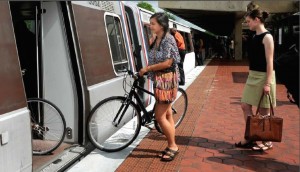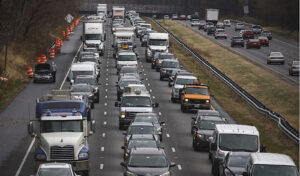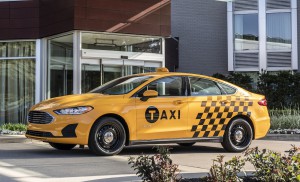Taxi business in New York City has dropped by 90% since the start of the pandemic, even as mass transit ridership has fallen precipitously.
The situation, repeated across the country, reflects a variety of factors, including a huge increase among those working from home and a sharp decline in business travel. But even among those who must commute, there’s been a sizable shift away from mass transit and ride-hailing services to the use of personal vehicles. And that is leading not only to a surge in car sales, both new and used, but also in the type of vehicles American motorists are purchasing.
Among new car buyers, in particular, motorists are ordering vehicles loaded with the latest in high-tech features, from smart safety devices to infotainment systems, as well as in-car WiFi and other technology, members of an expert panel agreed during a session at the virtual CES 2021.
(Pandemic may not have changed car buying habits of consumers.)

Workers who had previously taken public transportation are now shifting to driving themselves in large numbers.
“COVID is probably going to change commuting patterns permanently,” said Carla Bailo, the CEO of the Center for Automotive Research, noting research that finds only 20% of Americans expect to go back to their offices full-time, while 90% expect to go to an office less frequently. Americans “won’t revert back,” stressed Bailo, “even when we get through the COVID pandemic.”
It’s not just the way Americans travel for work that’s changing, added Bailo. Though tens of millions wound up traveling during the Christmas and New Year holidays, AAA found a significantly higher percentage took the family car, rather than flying or traveling by train, compared to pre-pandemic holidays.
“We’ll see for some time people reverting back to their cars for social holidays,” said Bailo.
The pandemic has not only made people more reliant on their cars for traveling, but seen people use their vehicles as places to work and even to get a break from family members after extensive isolation, said Christiane Zorn, a senior marketing executive with Audi. And the pattern is playing out in other global markets, as well, she added.
The car, suggested Zorn, is becoming “a personal device,” one increasingly loaded up with even more technology than the typical home or office, echoed Andrew Poliak, an executive with Panasonic Automotive.

Due to the pandemic, travel during the holidays was be down slightly, but most of those trekking to see friends and family were driving.
“We’re coming to this point of convergence,” Poliak said, where many of the things a person could do at home or office can be done in the car. Indeed, he added, it’s becoming increasingly common to have a better audio system in the family vehicle than in the typical living room.
(Auto industry “in much better place,” but price surge likely to continue.)
“Technology will play a big part in the design of the automotive interior in the future,” according to Poliak, and that’s reflected by some of the latest automobiles, such as the Cadillac Escalade, with its 39 inches of video screens. The new Mercedes-Benz EQS due out next year will have a “pillar-to-pillar” Hyperscreen display, the automaker announced during a separate CES event.
Tellingly, when Ford redesigned its F-150 for the 2021 model year it developed a retractable gearshift lever that opens up a large workspace that can be used for a motorist’s laptop computer.
While much of the new wave of technology is designed for passenger comfort and convenience, there’s also been significant growth in the use of advanced driver assistance systems, such as forward collision warning with automatic emergency braking. Some new models offers dozens of these smart safety features.

New and used car sales are on the rise as people move away from public transportation and back into personal vehicles for their commute.
And the first semi-autonomous driving systems, such as Tesla’s Autopilot and General Motors’ Super Cruise, are receiving warm public receptions. Stefan Buerkle, a senior vice president at mega-supplier Robert Bosch, expects to see the growth of auto-parking technologies that could allow a motorist to exit at their destination and then send their vehicle off to find a parking spot on its own. A press of a keyfob or a tap on a smartphone app would summon the vehicle later.
“You won’t have to park your car anymore, or go looking for a spot,” something that adds to urban congestion, said Buerkle. But there’s another advantage, he added. “That will also make much better use of the infrastructure, especially in cities, where space is at a premium.”
Self-parking technology could allow cities to shift to remote parking locations and reduce the need for lots to be set up in dense urban centers, the CES panelists agreed.
While such technology is likely still a few years from production, it will simply add to the trend that has seen new car prices rise rapidly in the last several years. At a separate conference last week, analysts from Cox Automotive noted that the typical new vehicle sold in the U.S. is now rolling off the dealer lot for a record price of around $40,000.
(Commuting may have changed forever, finds new study.)
But the new technologies showing up in the latest vehicles also seem likely to change the basic business model of the auto industry, Bailo and her fellow panelists said. The push to add 4G and even 5G connectivity will allow automakers to not only sell new vehicles but also develop new revenue streams. That will include providing in-vehicle entertainment and using smartphone-style over-the-air updates to add additional features, said Zorn, much as Tesla plans to do with the next major update of Autopilot.
/**/
For GREAT deals on a new or used Nissan check out Nissan of Sumter TODAY!
